Part of a series of articles titled Alaska Park Science - Volume 17, Issue 1. Migration: On the Move in Alaska.
Article
Duck-billed Dinosaurs (Hadrosauridae), Ancient Environments, and Cretaceous Beringia in Alaska’s National Parks
Paul J. McCarthy, University of Alaska
Yoshitsugu Kobayashi and Tomonori Tanaka, Hokkaido University Museum
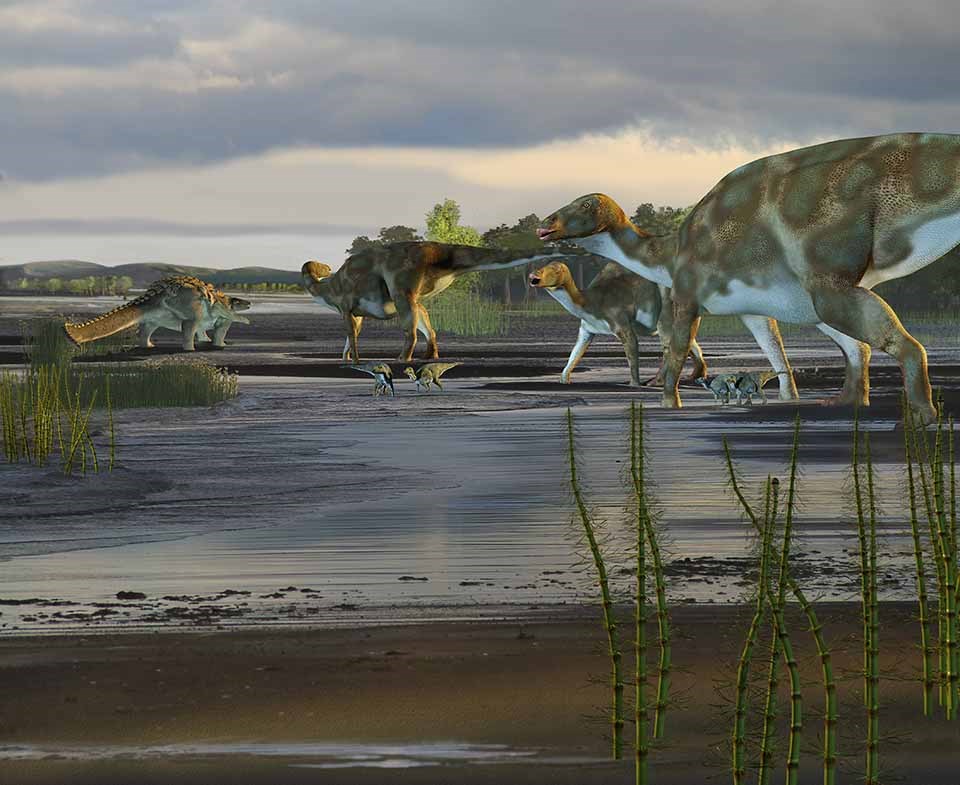
Artwork courtesy of Karen Carr
Beringia is a concept that was originally pro-posed for an hypothesized ice-free corridor between northeastern Asia and northwestern North America, a corridor that served as a refugium for plants during the Quaternary Epoch (Hultén 1937). More specifically, Hultén (1937) recognized floral similarities between these two areas of land and proposed the name Beringia for the presumed landmass that resulted from a sea level drop due to glacial advance. Since this first definition, the concept has grown, changed, and been used to explain the movement and distribution of many mammals across these same continents during the periodic existence of the land bridge (e.g., Repenning 1987, Hopkins 1967 and 1996, Hopkins et al. 1982, Guthrie 1982 and 2001).
Recent exploration of dinosaur faunas across these same two continents has shown similar broad features (e.g., bidirectional faunal exchange, complex system of vegetative zones, gregarious keystone species) in the Cretaceous Period as observed by these workers of Quaternary deposits (Fiorillo 2008). These newer perspectives on dinosaur biogeography across this region (e.g., Russell 1993, Cifelli et al. 1997, Sereno 2000, Fiorillo 2008) have increased our understanding of Beringia in deep time starting at least 110 million years ago, during the Cretaceous Period, when tectonics moved geologic plates into a configuration that allowed for a Beringian land bridge to first occur (Lawver et al. 2002). It was during the Cretaceous when dinosaurs roamed freely around what we now call Alaska. Here we present new information from Aniakchak National Monument and Preserve on the Alaska Peninsula, that, when compared to time-equivalent rock units elsewhere in Alaska, sheds light on the likely ancient environment that allowed the migration of one group of dinosaurs, the hadrosaurs (duck-billed dinosaurs), across Beringia during the Cretaceous.
Evidence of Cretaceous Dinosaurs in Alaska’s National Parks
Though the first technical description of Alaskan dinosaurs came from discoveries in northern Alaska (Roehler and Stricker 1984), the first dinosaur discovery in an Alaska park occurred in Aniakchak National Monument and Preserve (Fiorillo and Parrish 2004). Additional work in other parks has shown that Late Cretaceous rocks found within Denali National Park and Preserve (Fiorillo et al. 2007, 2009, 2011, 2014a, 2015; Fiorillo and Adams 2012, Fiorillo and Tykoski 2016, Tomsich et al. 2010), Yukon-Charley Rivers National Preserve (Fiorillo et al. 2014b), and Wrangell-St. Elias National Park and Preserve (Fiorillo et al. 2012) provide some of the most significant opportunities to examine in detail a mosaic of ancient high-latitude terrestrial ecosystems that supported dinosaurs. Examining the latest Cretaceous rocks within Denali and along the Colville River in northern Alaska has provided a more thorough understanding of not only dinosaurs, but associated fauna, environments, and the climate in which they lived. This regional ecosystem contained a rich dinosaurian fauna as well as other fossil vertebrates including mammals, birds, and fishes. The floral component of this paleoecosystem was similarly diverse and included a variety of angiosperms (flowering plants), gymnosperms (seed- or cone-bearing plants), and ferns (Fiorillo et al. 2010a, Tomsich et al. 2010, Flaig et al. 2013).
There is increasing evidence from older Cretaceous rock units such as the Nanushuk Formation of northern Alaska (Fiorillo et al. 2010b) as well as rocks along the middle and lower Yukon River (May et al. 2014) that Alaska has a rich dinosaur record even within the origin of Beringia. The age of these earlier rock units tells us, for example, that early members of the ceratopsians (horned dinosaurs; Fiorillo et al. 2010b), and hadrosaurs (duck-billed dinosaurs; Cifelli et al. 1997) were among the first to exploit ancient Beringia by moving across this land bridge from Asia into North America (Fiorillo et al. 2010b). The Cretaceous rocks of Alaska, and particularly within Alaska’s national parks, are potentially full of intellectually stimulating discoveries regarding the timing of migration for different dinosaurs across Beringia.
Examining the fossil bone deposits that are approximately 70 million years old within the Prince Creek Formation of northern Alaska, a rock unit now recognized as the most abundant source of polar dinosaur bones in the world (Rich et al. 2002), provides insight into the environmental preferences of different types of dinosaurs. By using a multi-disciplinary approach that included vertebrate paleontologic, sedimentologic, and paleobotanical data, Fiorillo and others (2016) showed that hadrosaurs preferred the wetter, lower delta plain environments, while the ceratopsians preferred habitat that was the more proximal, slightly elevated, and drier upper coastal plain (Fiorillo et al. 2016). Not surprisingly, predatory dinosaurs were not confined to a single ecosystem, but followed food resources in whatever ecosystems they could be found (Fiorillo et al. 2016).
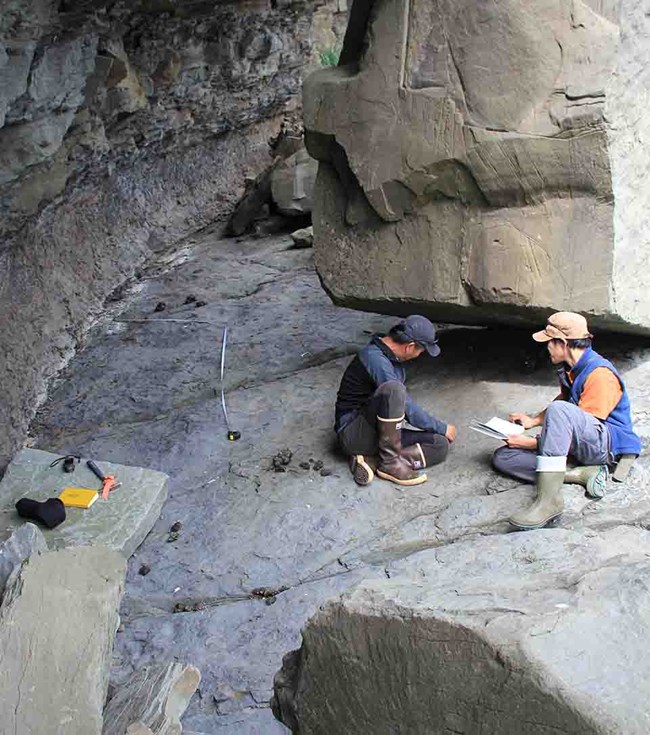
All photos courtesy of Anthony Fiorillo
New Insights from Aniakchak National Monument and Preserve
We have now discovered dozens of dinosaur tracks from exposures of the Cretaceous Chignik Formation in Aniakchak National Monument and Preserve a rock unit that was deposited at approximately its current latitude, which is almost 57o N (Hillhouse and Coe 1994). Tracks were photographed, measured (Figure 1), coordinates recorded, and molds were made of select representative tracks.
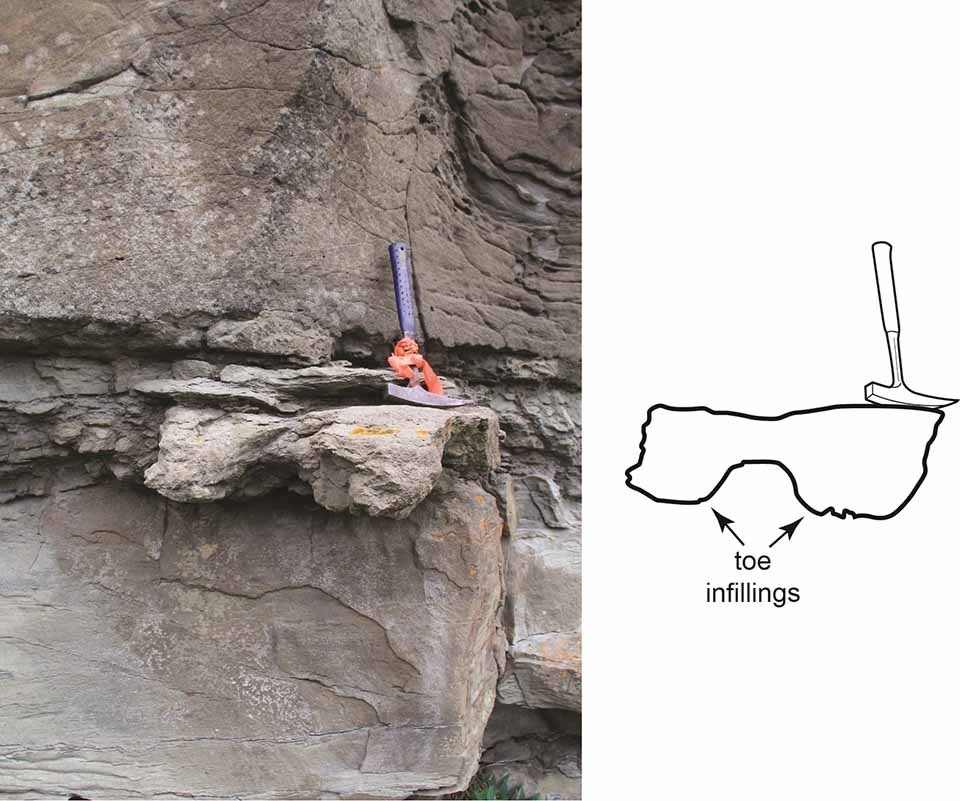
Tracks were found in cross-section within the face of cliffs (Figure 2) or in planar view either on in situ bedding planes (Figures 1 and 3) or on isolated eroded blocks that had fallen from the cliff face.
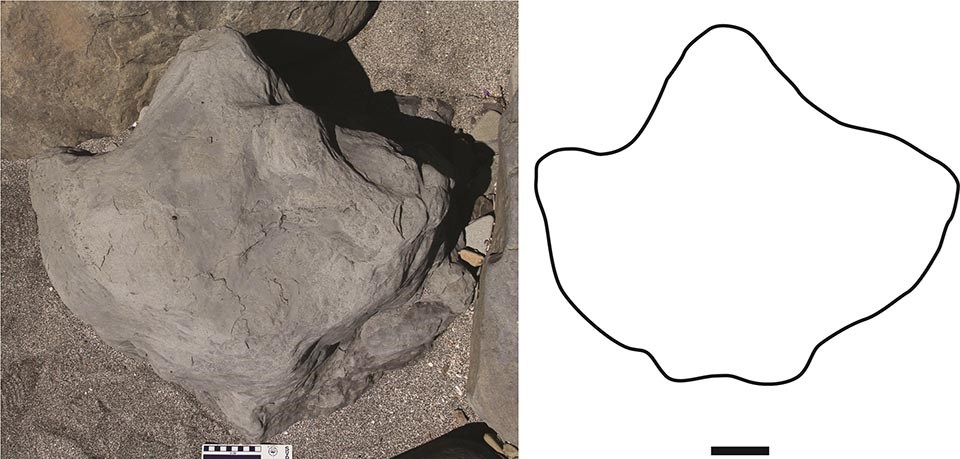
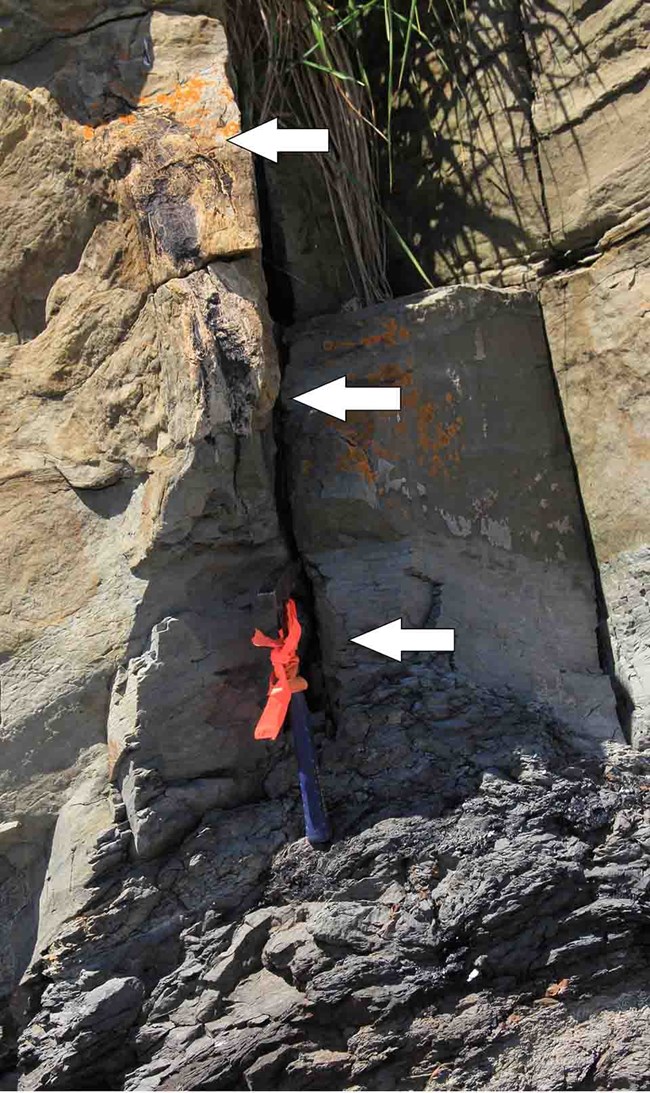
The white arrows point to the top, middle and bottom of the exposed tree trunk. The blue handle of the rock hammer is resting on the root mass.
The hadrosaur tracks range in size from those made by likely full-grown adults to juveniles. Tracks attributable to ankylosaurs (armored dinosaurs) are currently uncommon in frequency, while trace fossils left by birds and the fin rays of bony fishes are rare. Further, we documented a rich fossil flora that includes upright conifer tree trunks and numerous horizons with angiosperm leaves (Figures 4 and 5).
Previously there had been only three track sites recorded within the Chignik Formation (Fiorillo and Parrish 2004, Fiorillo et al. 2004, Fiorillo 2018), and only one track site recorded from the older (Jurassic) Naknek Formation (Druckenmiller et al. 2011), a rock unit that crops out extensively along the Alaska Peninsula, including in Aniakchak National Monument and Preserve, and Katmai and Lake Clark national parks and preserves. The recent work in Aniakchak that includes re-evaluating the potential fossil resources of the Chignik Formation has now revealed over 50 new track sites, dramatically increasing the dinosaur record from not only Aniakchak National Monument and Preserve, but the entire Alaska Peninsula. It also makes Aniakchak the second-most important park in Alaska, after Denali, for studying dinosaurs, their ecosystems, and the climate in which the dinosaurs lived.
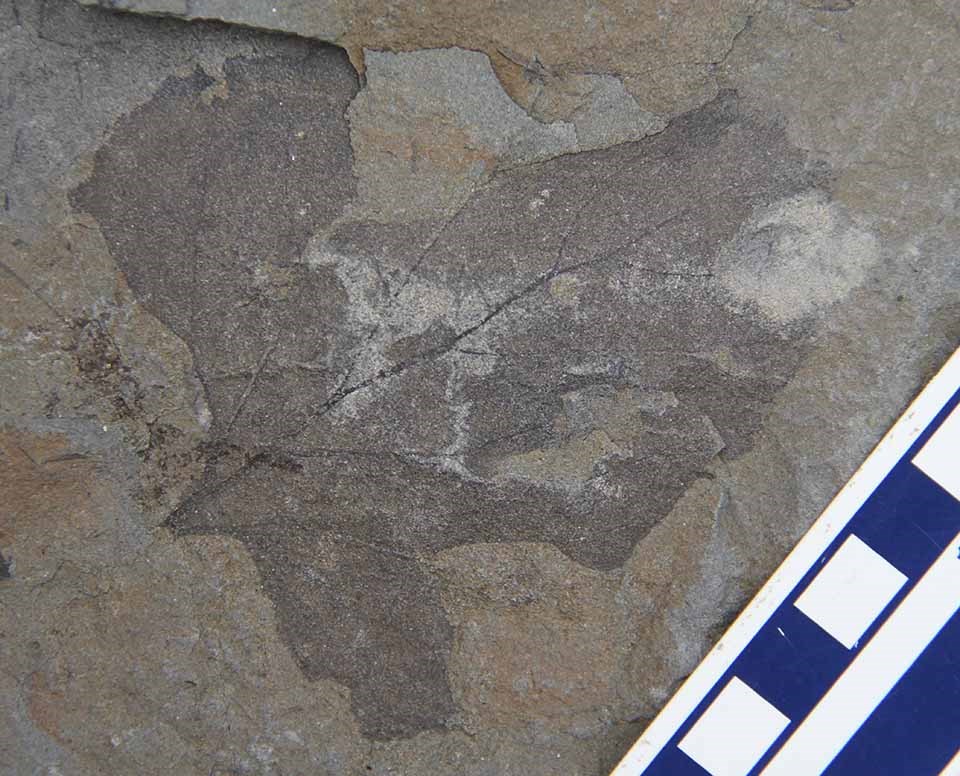
What these Findings Tell Us about Migration
The discovery of dinosaurs so far north initially puzzled researchers and one of the early ideas was that they must undergo large-scale migration to cope with the high-latitude environment. While it is no longer thought that hadrosaurs survived the winter using seasonal migrations like those of modern caribou (Fiorillo and Gangloff 2001), evidence does suggest that dinosaurs migrated between what is now modern Asia and North America through Alaska during the Cretaceous.
The modern depositional environments in the distal part of the Aniakchak River as it makes its way into Aniakchak Bay provide a superb modern analog for the Late Cretaceous Chignik Formation (Figure 6).

Overall, the Chignik Formation is a cyclic succession of sedimentary rocks representing shallow marine environments in the lower part and predominantly non-marine environments in the upper part (Fairchild 1977, Detterman 1978, Detterman et al. 1996). The part of the section measured in detail in 2016 represents primarily non-marine deposition on an ancient alluvial-deltaic coastal plain (Figure 7). There is also evidence of tidal influence on some of the distal deposits, including tidal flats as well as marginal marine beach and estuarine deposits. The Cretaceous coastal plain was dominated by sinuous meandering fluvial channels, with abundant crevasse splays, small lakes and ponds, and a few thin peat swamps.
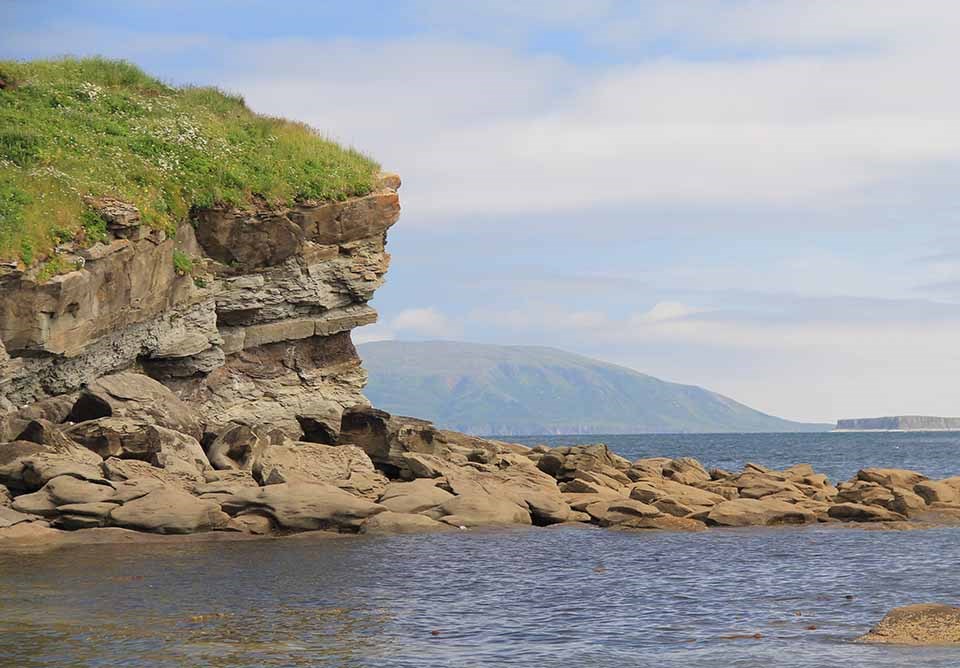
The partially correlative and well-known dinosaur remains of the Prince Creek Formation 870-930 miles (1,400-1,500 kilometers) farther north in Alaska partially overlap in age with these discoveries in the Chignik Formation (see Fiorillo and Parrish 2004, Flaig et al. 2014). Preliminary results of this similar interdisciplinary study in the Chignik Formation seem to corroborate the habitat preference model for Cretaceous high-latitude hadrosaurs proposed for the hadrosaurs of the Prince Creek Formation. That is, hadrosaurs preferred areas that included lowland deltas and other tidally influenced habitats. This understanding of hadrosaurs’ habitat preference allows specific questions on how that habitat might change through time and space. Continued fine-tuning of our understanding of the details of these habitat preferences will not only illuminate the potential causal mechanisms for non-recurrent migration in Cretaceous Beringia, but also tell us something about large-scale ecosystem processes through deep geologic time.
REFERENCES
Cifelli, R. L., J. I. Kirkland, A. Weil, A. L. Deino, and B. J. Kowallis. 1997.
High-precision 40Ar/39Ar geochronology and the advent of North America’s Late Cretaceous terrestrial fauna. Proceedings of the National Academy of Sciences of the United States of America 94:11,163–11,167.
Detterman, R. L. 1978.
Interpretation of depositional environments in the Chignik Formation, Alaska Peninsula. United States Geological Survey Circular 772-B:B62-B63.
Detterman, R. L., J. E. Case, J. W. Miller, F. H. Wilson, and M. E. Yount. 1996.
Stratigraphic framework of the Alaska Peninsula. United States Geological Survey Bulletin 1969-A:1-74.
Druckenmiller, P. S., K. May, R. Blodgett, P. McCarthy, and S. Fowell. 2011.
A step back in time: Oldest record of Alaskan dinosaurs from the Upper Jurassic Naknek Formation, Peninsular terrane, Alaska Peninsula. AAPG Pacific Section Meeting 6-14 May, Program with Abstracts, p. 51.
Fairchild, D. T. 1977.
Paleoenvironments of the Chignik Formation, Alaska Peninsula. Master’s thesis, University of Alaska, Fairbanks, 168 pp. (Unpublished).
Fiorillo, A. R. 2018.
Alaska Dinosaurs: an Ancient Arctic World. CRC Press, Boca Raton.
Fiorillo, A. R. 2008.
Cretaceous dinosaurs of Alaska: Implications for the origins of Beringia. Pages 313-326 in The Terrane Puzzle: New perspectives on paleontology and stratigraphy from the North American Cordillera, edited by R. B. Blodgett and G. Stanley. Geological Society of America Special Paper 442. Boulder, CO.
Fiorillo, A. R. and R.S. Tykoski. 2016.
Small hadrosaur manus and pes tracks from the lower Cantwell Formation (Upper Cretaceous), Denali National Park, Alaska: Implications for locomotion in juvenile hadrosaurs. Palaios 31:479-482.
Fiorillo, A. R. and T. L. Adams. 2012.
A therizinosaur track from the Lower Cantwell Formation (Upper Cretaceous) of Denali National Park, Alaska. Palaios 27:395-400.
Fiorillo, A. R. and J. T. Parrish. 2004.
The first record of a Cretaceous dinosaur from southwestern Alaska. Cretaceous Research 25:453-458.
Fiorillo, A. R. and R. A. Gangloff. 2001.
The caribou migration model for Arctic hadrosaurs (Dinosauria: Ornithischia): A reassessment. Historical Biology 15:323-334.
Fiorillo, A. R., P. J. McCarthy, and P. P. Flaig. 2016.
A multi-disciplinary perspective on habitat preferences among dinosaurs in a Cretaceous Arctic greenhouse world, North Slope, Alaska (Prince Creek Formation: lower Maastrichtian). Palaeogeography, Palaeoclimatology, Palaeoecology 441:377-389.
Fiorillo, A. R., Y. Kobayashi, P. J. McCarthy, T. C. Wright, and C. S. Tomsich. 2015.
Reports of pterosaur tracks from the Lower Cantwell Formation (Campanian-Maastrichtian) of Denali National Park, Alaska, U.S.A., with comments about landscape heterogeneity and habitat preference. Historical Biology 27:672-683
Fiorillo, A. R., S. T. Hasiotis, and Y. Kobayashi. 2014a.
Herd structure in Late Cretaceous polar dinosaurs: a remarkable new dinosaur tracksite, Denali National Park, Alaska, USA. Geology 42:719-722.
Fiorillo, A. R., F. Fanti, C. Hults, and S. T. Hasiotis. 2014b.
New ichnological, paleobotanical and detrital zircon data from an unnamed rock unit in Yukon-Charley Rivers National Preserve (Cretaceous: Alaska): stratigraphic implications for the region. Palaios 29:16-26.
Fiorillo, A. R., T. L. Adams, and Y. Kobayashi. 2012.
New sedimentological, palaeobotanical, and dinosaur ichnological data on the palaeoecology of an unnamed Late Cretaceous rock unit in Wrangell-St. Elias National Park and Preserve, Alaska, USA. Cretaceous Research 37:291-299.
Fiorillo, A. R., S. T. Hasiotis, Y. Kobayashi, B. H. Breithaupt, and P. J. McCarthy. 2011.
Bird tracks for the Upper Cretaceous Cantwell Formation of Denali National Park, Alaska, USA: a new perspective on ancient polar vertebrate biodiversity. Journal of Systematic Palaeontology 9:33-49.
Fiorillo, A. R., P. J. McCarthy, P. P. Flaig, E. Brandlen, D. W. Norton, P. Zippi, L. Jacobs, and R. A. Gangloff. 2010a.
Paleontology and paleoenvironmental interpretation of the Kikak-Tegoseak Quarry (Prince Creek Formation: Late Cretaceous), northern Alaska: a multi-disciplinary study of a high-latitude ceratopsian dinosaur bonebed. Pages 456-477 in New Perspectives on Horned Dinosaurs, edited by M. J. Ryan, B. J. Chinnery-Allgeier, and D. A. Eberth. Indiana University Press, Bloomington.
Fiorillo, A. R., P. L. Decker, D. L. LePain, M. Wartes, and P. J. McCarthy. 2010b.
A probable Neoceratopsian Manus Track from the Nanushuk Formation (Albian, Northern Alaska). Journal of Iberian Geology 36:165-174.
Fiorillo, A. R., S. T. Hasiotis, Y. Kobayashi, and C. S. Tomsich. 2009.
A pterosaur manus track from Denali National Park, Alaska Range, Alaska, USA. Palaios 24:466-472.
Fiorillo, A. R., P. J. McCarthy, B. Breithaupt, and P. Brease. 2007.
Dinosauria and fossil Aves footprints from the Lower Cantwell Formation (latest Cretaceous), Denali Park and Preserve, Alaska. Alaska Park Science 6:41-43.
Fiorillo, A. R., R. Kucinski, and T. R. Hamon. 2004.
New frontiers, old fossils: recent dinosaur discoveries in Alaska’s National Parks. Alaska Park Science 3:4-9.
Flaig, P. P., A. R. Fiorillo, and P. J. McCarthy. 2014.
Dinosaur-bearing hyperconcentrated flows of Cretaceous Arctic Alaska: recurring catastrophic event beds on a distal paleopolar coastal plain. Palaios 29: 594-611.
Flaig, P. P., P. J. McCarthy, and A. R. Fiorillo. 2013.
Anatomy, evolution and paleoenvironmental interpretation of an ancient Arctic coastal plain: Integrated paleopedology and palynology from the Upper Cretaceous (Maastrichtian) Prince Creek Formation, North Slope, Alaska, USA. Pages 179-230 in New Frontiers in Paleopedology and Terrestrial Paleoclimatology: Paleosols and Soil Surface Analogue Systems, edited by S. G. Driese, and L. C. Nordt. SEPM Special Publication 104.
Guthrie, R. D. 2001.
Origin and causes of the mammoth steppe: A story of cloud cover, woolly mammal tooth pits, buckles, and inside-out Beringia. Quaternary Science Reviews 20:549–574.
Guthrie, R. D. 1982.
Mammals of the mammoth steppe as paleoenvironmental Indicators. Pages 307-326 in Paleoecology of Beringia, edited by D. M. Hopkins, J.V. Matthews, Jr., C. E. Schweger, and S. B. Young. Academic Press, New York.
Hillhouse, J. W. and R. S. Coe. 1994.
Paleomagnetic data from Alaska. Pages 797-812 in Geology of Alaska, The Geology of North America, v. G-1, edited by G. Plafker and H. C. Berg. Geological Society of America, Boulder.
Hopkins, D. M. 1996.
Introduction: The concept of Beringia. Pages xvii–xxi in American Beginnings: The prehistory and palaeoecology of Beringia, edited by F. H. West. University of Chicago Press. Chicago.
Hopkins, D. M. (ed.). 1967.
The Bering Land Bridge: Stanford, Stanford University Press.
Hopkins, D. M., J. V . Matthews, Jr., C. E. Schweger, and S. B. Young (eds). 1982.
Paleoecology of Beringia. Academic Press, New York.
Hultén, E. 1937.
Outline of the history of Arctic and Boreal biota during the Quarternary period. Strauss und Cramer. Germany. Reprint of the Stockholm edition.
Lawver, L. A., A. Grantz, and L. M. Gahagan. 2002.
Plate kinematic evolution of the present Arctic Region Since the Ordovician, in Miller, E. L., Grantz, A., and Klemperer, S.L., eds., Tectonic evolution of the Bering Shelf-Chukchi Sea-Arctic margin and adjacent landmasses: Geological Society of America Special Paper 360: 333–358.
May, K. C., P. Druckenmiller, P. J. McCarthy, J. Hurum, J. Rousseau, and K. L. Anderson. 2014.
Tracking dinosaurs along the Yukon River: A new dinosaur-dominated ichnofossil assemblage from the Cretaceous arctic of Alaska. Society of Vertebrate Paleontology, Annual Meeting abstract, Berlin, Germany.
Repenning, C. A. 1987.
Biochronology of the microtine rodents of the United States. Pages 236–268 in Cenozoic mammals of North America: Geochronology and biostratigraphy, edited by M. O. Woodburne. University of California Press, Berkeley.
Rich, T. H., P. Vickers-Rich, and R. A. Gangloff. 2002.
Polar dinosaurs. Science 295: 979–980.
Roehler, H. W. and G. D. Stricker. 1984.
Dinosaur and wood fossils from the Cretaceous Corwin Formation in the National Petroleum Reserve, North Slope, Alaska. Journal of the Alaska Geological Society 4:35-41.
Russell, D. A. 1993.
The role of central Asia in dinosaurian biogeography. Canadian Journal of Earth Sciences 30: 2002–2012.
Sereno, P. C. 2000.
The fossil record, systematics and evolution of pachycephalosaurs and ceratopsians from Asia. Pages 480–516 in The age of dinosaurs in Russia and Mongolia, edited by M. J. Benton, M. A. Shishkin, D. M. Unwin, and E. N. Kurochkin. Cambridge University Press, Cambridge.
Tomsich, C. S., P. J. McCarthy, S. J. Fowell, and D. Sunderlin. 2010.
Paleofloristic and Paleoenvironmental Information from a Late Cretaceous (Maastrichtian) Flora of the Lower Cantwell Formation near Sable Mountain, Denali National Park, Alaska. Palaeogeography, Palaeoclimatology, Palaeoecology 295: 389–408.
Last updated: January 17, 2024
